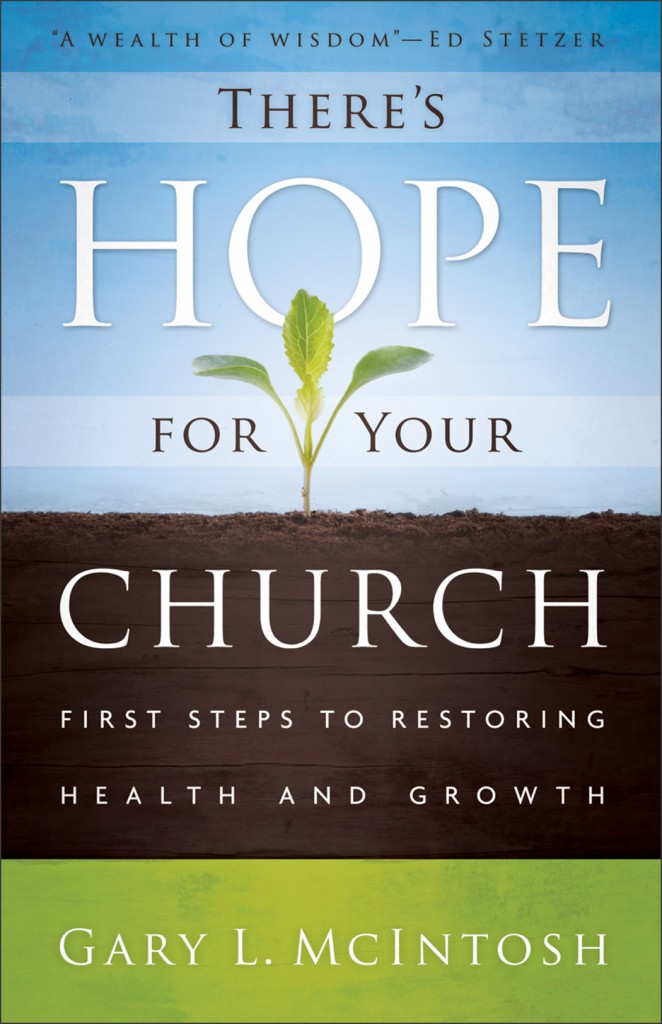Book Review: There’s Hope for Your Church, by Gary McIntosh
August 27, 2012

August 27, 2012
No church is perfect. Well, not yet anyway.
Christ laid down his life for the church and will one day present her holy and blameless. But this side of heaven, churches are filled with sinners fighting for holiness. So whether a pastor hopes to plant a church, revitalize, or has served in the same place for decades, reform is always on the agenda.
How can a pastor lead his congregation to reach more people with the gospel? Grow in holiness? Resolve divisions and disputes? Train up future leaders?
In his book There’s Hope for Your Church, Gary McIntosh aims to help pastors lead their church in a new direction. For struggling churches, the book is intended to be a life preserver. But as with any book, readers need to be discerning. A drowning man won’t complain about the color of the life preserver, but not every life preserver will float you to safety. People who read the book should heed its wise advice, yet tread carefully with some of the underlining assumptions.
SOME WISE ADVICE
McIntosh, who previously served as a pastor and is currently president of a church-consulting network that has worked with thousands of churches, has some good advice for pastors. For example, his “Church Revitalization Chart,” which becomes the 13 chapters of the book, presents a helpful process to think through as you are leading change. The author doesn’t suggest the process should be followed rigidly, but it does give pastors insightful categories and questions to assess where a congregation might be.
The book is also realistic about the challenges of pastoral ministry. Rather than suggesting an easy shortcut (which doesn’t exist), the author challenges pastors to do what God desires rather than following the whims of people (27), to rely on God in prayer (60), to lead in repentance (60), and to persevere rather than leave when it gets tough (34).
Further, there’s a refreshing call to gospel proclamation. Churches looking for hope may be tempted to get rid of the offense of the cross and adopt more palatable methods to draw people in. But McIntosh writes, “While churches certainly are right to serve others, they are called to do more. Churches are called to make disciples by preaching the Good News of salvation through the death and resurrection of Jesus” (64).
PASTORING, POM-POMS, AND THE SUFFICIENCY OF SCRIPTURE
Despite this good material, there are other concerns that make me reluctant to recommend the book. There is a nod to the biblical basis for hope in chapter one, but the rest of the book lifts up a positive attitude as the key for church revitalization (95). At one point, the author suggests creating “a series of small successes—baby steps—to build up faith. Short-term projects, such as painting the auditorium, replacing carpet in classrooms, or restoring the landscape around the facilities, can help build up faith” (62). I’m all for good morale. No one wants to join a depressing church. But addressing the symptom (low morale) without addressing the root problem (lack of faith, idolatry, and so on) won’t fix anything.
Our faith does not come from a positive attitude—it comes from hearing God’s Word (Rom. 10:17). Pastors are not called to be cheerleaders who work people up into a frenzy about “wins.” Instead, we’re called to humbly and confidently preach God’s Word. As the Spirit of God illumines hearts and minds, hope is established, affections blaze for him, and lives are truly transformed.
Another way of expressing this concern is considering the basis for what’s being said. The idea that drives conclusions throughout the book is the repeated phrase “research shows.” Research is great—but I get nervous when I’m told to pray because research shows that it works (59). God calls us to pray (1 Thess. 5:17, 2 Thess. 3:1, Jas. 5:13, 1 Pet. 4:7); but what if research showed that prayer doesn’t work? Would that mean I shouldn’t pray? When research and pragmatism drive the ship, we’re in danger of letting good intentions lead us into disobeying God.
For those who read the book, I’d encourage you to read asking yourself, “What is the basis for what I’m being told? What does Scripture say about it?”
Consider a few other examples: “For your church to be revitalized you must form your own dominant coalition” (86). Revitalization calls for a coalition of leaders? Sounds good! But rather than looking to Jim Collins’s business principles or George Barna’s “Berry Theory,” why not consider what Scripture says about elders and deacons (1 Tim. 3:1-13; 2 Tim. 2:2; Tit. 1:5-16; 1 Pet. 5:1-4)?
Or again, “Studies completed on pastors who have successfully revitalized a church demonstrate that such pastors are invariably either a D or an I” (31; referring to the DISC personality profile). No doubt action-oriented personalities are decisive, directive, and can get things done. But does that mean Moses (Ex. 4:10) or Jeremiah (Jer. 1:6) would be disqualified? Are there not other traits we should be looking for in our leaders (1 Tim. 3:1-7)?
IS THERE HOPE FOR YOUR CHURCH?
The hope of a pastor facing the daunting challenges of shepherding is not the latest research or business model, however helpful they might be in their place—it’s the Bible. It’s the Bible that gives life and creates God’s people (Ezek. 37:1-14). It’s Scripture that transforms his people (Rom. 12:2) and shows us God’s vision for the church (Eph. 3:10). It’s God’s Word that gets us to the finish line (Jude 24).
Is there hope for your church? You’ll find it as you let an unswerving confidence in the truth and sufficiency of Scripture shape your preaching, leading, and evangelizing.